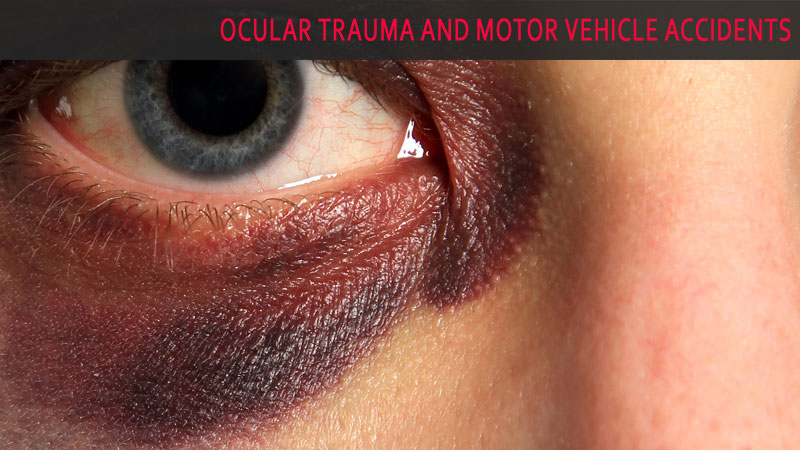Ocular Trauma and Motor Vehicle Accidents
 Ocular Trauma is a condition with a bimodal age distribution occurring more frequently in the adolescent years and in the later years in life 1-3. Eye trauma is a significant cause of visual loss in both the developed and underdeveloped world despite it being largely preventable [4]. Work-related injuries and sports trauma are the most prevalent.
Ocular Trauma is a condition with a bimodal age distribution occurring more frequently in the adolescent years and in the later years in life 1-3. Eye trauma is a significant cause of visual loss in both the developed and underdeveloped world despite it being largely preventable [4]. Work-related injuries and sports trauma are the most prevalent.
Motor Vehicle Accidents (MVA) are a source of ocular trauma and although passengers (and drivers) are more likely to survive a severe MVA today (because of increased safety features in autos today), ocular injury is especially common. With increased survival however, there is a higher incidence of associated injury that requires treatment.
Ocular injuries from motor vehicle accidents can be as severe as loss of an eye or as minimal as a small abrasion. There can be foreign body penetration, laceration of the cornea or sclera or even globe rupture from blunt force. When severe injury occurs, the prognosis for visual potential is poor. Once the patient is transferred to the hospital, the life-threatening injuries are attended to first and then primary repair of the eye may be necessary (once medically stable). Primary repair is often followed by a secondary retina surgery if there is retinal involvement from the trauma.
Studies show that although airbags seem to decrease the incidence of severe ocular trauma, there is an offsetting increase in minor ocular injury from their deployment [5]. Since the mandated use of airbags in 1997, the number of fatal injuries have been reduced by 31-32% (significant improvement over the reduction by seatbelts) [6]. The various injuries related to airbag deployment include (not limited to) corneal abrasions, corneal burns, periocular burns/bruising, orbital fractures, corneal lacerations, hyphemas, uveitis, retinal detachment and ruptured globes [7].
The treatments of the various ocular injuries is case dependent. Some patients require only antibiotic drops to reduce the risk of secondary infection (after an abrasion or laceration). Others require major surgery to close the wound or even subsequent retinal detachment repair. In some instances, removal of the eye (evisceration or enucleation) may be required.
Fortunately, the life-preserving benefits of the airbags outweighs the risks of bodily trauma but the incidence of ocular trauma from these deployments is not uncommon. Furthermore, the increased safety technology in more recent automobiles has preserved life in major MVA’s at a level never seen before.
Charles WG Eifrig, MD, a Laguna Hills Eye Doctor with the Retina Associates of Orange County, with locations in Newport Beach, Laguna Hills, and Santa Ana, California, offers valuable information regarding ocular trauma injuries as a result of an automobile accident.
References:
- Banta JT. Ocular Trauma. Philadelphia, PA: Saunders. May 2007.
- klopfer J, Thiersch JM, Vitale S, et al. Ocular trauma in the United States: eye injuries resulting in hospitalization, 1984 through 1987. Arch Ophthalmic 1992; 110-838-842
- Wong TY, Tielsch JM. A population-based study on the incidence of severe ocular trauma in Singapore. Am J Ophthalmic 1999:128:345-351.
- Dannenberg AL, Parver LM, Brechner RK, Khoo L. Penetrating eye injuries in the workplace, the national eye trauma system registry. Arch Ophthalmol 1992;110-843-848.
- Duma SM, Jernigan MV, Stitzel JD, et al. The effect of frontal airbags on eye injury patterns in automobile crashes. Arch Ophthalmic 2002;120:1517-1522.
- Serrano JC, Chalela P, Arias JD. Epidemiology of childhood ocular trauma in a northeastern Columbian region. Arch Ophthalmic 2003;121:1439-1445.
- Miller DM, Eifrig CWG, Banta JT. Open Globe Injuries: Ruptures and Lacerations. In: Banta JT, ed. Ocular Trauma. Philadelphia , PA : Saunders; 2007: 163-180.